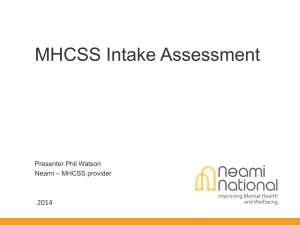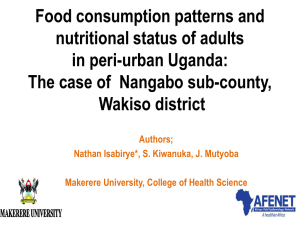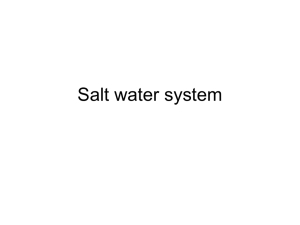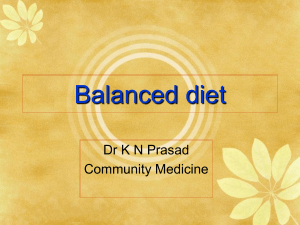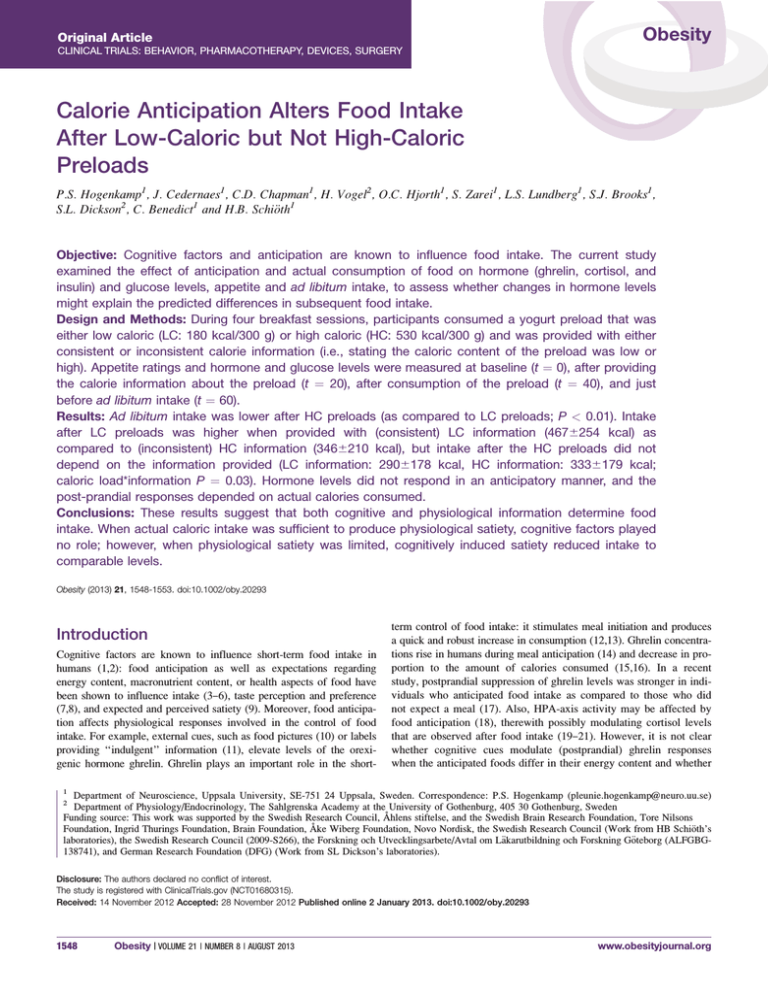
Obesity
Original Article
CLINICAL TRIALS: BEHAVIOR, PHARMACOTHERAPY, DEVICES, SURGERY
Calorie Anticipation Alters Food Intake
After Low-Caloric but Not High-Caloric
Preloads
P.S. Hogenkamp1, J. Cedernaes1, C.D. Chapman1, H. Vogel2, O.C. Hjorth1, S. Zarei1, L.S. Lundberg1, S.J. Brooks1,
oth1
S.L. Dickson2, C. Benedict1 and H.B. Schi€
Objective: Cognitive factors and anticipation are known to influence food intake. The current study
examined the effect of anticipation and actual consumption of food on hormone (ghrelin, cortisol, and
insulin) and glucose levels, appetite and ad libitum intake, to assess whether changes in hormone levels
might explain the predicted differences in subsequent food intake.
Design and Methods: During four breakfast sessions, participants consumed a yogurt preload that was
either low caloric (LC: 180 kcal/300 g) or high caloric (HC: 530 kcal/300 g) and was provided with either
consistent or inconsistent calorie information (i.e., stating the caloric content of the preload was low or
high). Appetite ratings and hormone and glucose levels were measured at baseline (t ¼ 0), after providing
the calorie information about the preload (t ¼ 20), after consumption of the preload (t ¼ 40), and just
before ad libitum intake (t ¼ 60).
Results: Ad libitum intake was lower after HC preloads (as compared to LC preloads; P < 0.01). Intake
after LC preloads was higher when provided with (consistent) LC information (4676254 kcal) as
compared to (inconsistent) HC information (3466210 kcal), but intake after the HC preloads did not
depend on the information provided (LC information: 2906178 kcal, HC information: 3336179 kcal;
caloric load*information P ¼ 0.03). Hormone levels did not respond in an anticipatory manner, and the
post-prandial responses depended on actual calories consumed.
Conclusions: These results suggest that both cognitive and physiological information determine food
intake. When actual caloric intake was sufficient to produce physiological satiety, cognitive factors played
no role; however, when physiological satiety was limited, cognitively induced satiety reduced intake to
comparable levels.
Obesity (2013) 21, 1548-1553. doi:10.1002/oby.20293
Introduction
Cognitive factors are known to influence short-term food intake in
humans (1,2): food anticipation as well as expectations regarding
energy content, macronutrient content, or health aspects of food have
been shown to influence intake (3–6), taste perception and preference
(7,8), and expected and perceived satiety (9). Moreover, food anticipation affects physiological responses involved in the control of food
intake. For example, external cues, such as food pictures (10) or labels
providing ‘‘indulgent’’ information (11), elevate levels of the orexigenic hormone ghrelin. Ghrelin plays an important role in the short-
term control of food intake: it stimulates meal initiation and produces
a quick and robust increase in consumption (12,13). Ghrelin concentrations rise in humans during meal anticipation (14) and decrease in proportion to the amount of calories consumed (15,16). In a recent
study, postprandial suppression of ghrelin levels was stronger in individuals who anticipated food intake as compared to those who did
not expect a meal (17). Also, HPA-axis activity may be affected by
food anticipation (18), therewith possibly modulating cortisol levels
that are observed after food intake (19–21). However, it is not clear
whether cognitive cues modulate (postprandial) ghrelin responses
when the anticipated foods differ in their energy content and whether
1
Department of Neuroscience, Uppsala University, SE-751 24 Uppsala, Sweden. Correspondence: P.S. Hogenkamp (pleunie.hogenkamp@neuro.uu.se)
Department of Physiology/Endocrinology, The Sahlgrenska Academy at the University of Gothenburg, 405 30 Gothenburg, Sweden
˚ hlens stiftelse, and the Swedish Brain Research Foundation, Tore Nilsons
Funding source: This work was supported by the Swedish Research Council, A
˚ ke Wiberg Foundation, Novo Nordisk, the Swedish Research Council (Work from HB Schi€
Foundation, Ingrid Thurings Foundation, Brain Foundation, A
oth’s
laboratories), the Swedish Research Council (2009-S266), the Forskning och Utvecklingsarbete/Avtal om L€akarutbildning och Forskning G€
oteborg (ALFGBG138741), and German Research Foundation (DFG) (Work from SL Dickson’s laboratories).
2
Disclosure: The authors declared no conflict of interest.
The study is registered with ClinicalTrials.gov (NCT01680315).
Received: 14 November 2012 Accepted: 28 November 2012 Published online 2 January 2013. doi:10.1002/oby.20293
1548
Obesity | VOLUME 21 | NUMBER 8 | AUGUST 2013
www.obesityjournal.org
Original Article
Obesity
CLINICAL TRIALS: BEHAVIOR, PHARMACOTHERAPY, DEVICES, SURGERY
these changes in hormone levels may contribute to possible differences in subsequent food intake. To test this, participants in the present
study were offered two low-caloric (LC) and two high-caloric (HC)
preloads over four visits. Both the LC and HC preloads were presented once with consistent calorie information (i.e., low or high)
and once with inconsistent calorie information (i.e., high or low).
We assessed pre-prandial and post-prandial plasma levels of ghrelin, as
well as cortisol concentrations. In addition, LC foods (grapes), HC
foods (muffins), and foods with an intermediate energy density (bread)
were offered ad libitum 30 min following the preload. Energy intake
was calculated to determine whether cognitive factors modulate subsequent food intake. We hypothesized that ad libitum food intake would
be lower following the preloads that were presented with LC information and that incongruent calorie information would modulate the appetite hormone responses (ghrelin, insulin, and cortisol).
Methods
Participants
In a randomized, cross-over design with four conditions, 12 healthy
young women [age: 2361.8 y, BMI: 22.861.9 kg/m2, restraint score
on the Three Factor Eating Questionnaire (22): 1161.6], with regular breakfast intakes (equal to or more than five times a week), no
regular intake of artificially sweetened products, and no use of sugar
in coffee and/or tea, consumed a LC preload and a HC preload
twice. Both preloads were provided once with LC information (LCinfo) and once with HC information (HC-info). Exclusion criteria
were as follows: hypersensitivity to the ingredients of the foods used
in the study, reported lack of appetite, following an energy-restricted
diet or a change in body weight of >5 kg during the last 3 months,
or being a vegan/vegetarian. We explained the study procedures
(described below) in a meeting preceding the experiment, in which
participants also gave their written informed consent. Participants
were, however, unaware of the exact aim of the study and were
informed that we wanted to ‘‘investigate the body’s response to the
different energy loads’’. They were asked to report the (guessed)
aim after at the last session. All participants were debriefed after
completion of their trials. The study was conducted according to the
guidelines provided in the Declaration of Helsinki; all procedures
were approved by the regional ethics committee of Uppsala (EPN),
and the study is registered with ClinicalTrials.gov (NCT01680315).
Design and procedures
Participants were instructed to refrain from alcohol, caffeine, food
intake, and drinks except water after 22.00 the day before each test
day and not to consume anything in the morning before arrival at
the research centre at 07.30. Each session took place on a separate
testing day, with a minimum wash-out period of 5 days between
each session. Blood was sampled four times, at 0, 20, 40, and 60
min after inserting and using a venous cannula. Immediately after
each blood sample, participants rated their appetite sensations (hunger, fullness, desire to eat, and prospective consumption) and thirst
on 100-mm visual analogue scales (VAS), anchored ‘‘not at all’’
and ‘‘extremely’’. Product information (described below) was provided after the first blood sample (t ¼ 0-20), participants tasted,
rated, and consumed the preload after the second blood sample (t ¼
20-40), and after the third blood sample (t ¼ 40-60), participants
filled out an evaluation questionnaire. Finally, they received their ad
libitum breakfast after the fourth blood sample (t ¼ 60-80). Following ad libitum consumption, participants once more evaluated their
appetite sensation (t ¼ 80; Figure 1). For tasting and rating the preloads, participants consumed one spoonful and evaluated the perceived pleasantness, sweetness, sourness, creaminess, and thickness
of the yogurt on a 100-mm VAS, anchored ‘‘not at all’’ and
‘‘extremely’’. This was repeated in the evaluation questionnaire.
This procedure was repeated for all four conditions. The order of
conditions was randomized within and balanced between
participants.
Test foods
Participants were served 300 g of LC yogurt (60 kcal/100 g) or HC
yogurt (177 kcal/100 g) preloads. The HC preload consisted of 219
g of commercially available mild natural yogurt (Mild l€
attyoghurt
naturell, Arla Foods), 66 g of table sugar, and 15 g of sunflower oil
(Zeta). To match the LC preload in sweetness, 1.92 g artificial
sweetener (cyclamate; Suketter: Cederroth International) dissolved in
8 g of water was added to 290 of the yogurt. The preloads were
served in transparent cups.
FIGURE 1 Experimental design. Blood was sampled every 20 min, and participants evaluated their appetite sensation (hunger, fullness, desire to eat, prospective consumption, and thirst) on a 100-mm visual analogue scale immediately after each blood sample.
www.obesityjournal.org
Obesity | VOLUME 21 | NUMBER 8 | AUGUST 2013
1549
Obesity
Calorie Anticipation and Food Intake Hogenkamp et al.
After the preload, participants were provided with a breakfast plate
that consisted of 300 g of white grapes (64 kcal/100 g), 10 triangles
of fruit bread (18 g each) with 8 g of butter (312 kcal/100g; Fruktkusar; Fazer), and 5 muffins of 20 g each (430 kcal/100g; Citronmuffins; H€agges). Participants were provided an additional plate to
avoid ‘‘empty your plate’’ behavior (23,24). This happened only
twice, with the same participant, and both times when the provided
product information stated LC content.
the conditions. We included the time variable in the model to test for
a time effect for the appetite ratings and blood parameters, and we
tested for the effect of caloric content and caloric information on
appetite sensations and blood parameters at the individual time
points. Data were analyzed using SAS (version 9.3; SAS Institute).
Results at a P-value of <0.05 were considered significantly different.
Results
Calorie information
Ad libitum energy intake
In the ‘‘low-calorie information’’-condition (LC-info), we provided a
product description that stated that the preload is ‘‘a healthy breakfast
product,’’ ‘‘light and fresh,’’ ‘‘low in fat and calories,’’ and ‘‘without
added sugar’’. We also provided a list of ingredients (including nonfat
milk and vitamin A and D) and nutrition facts [energy (kcal) and
macronutrients (g/100 g)]. In addition, participants were asked to calculate the energy percentage of protein, the total amount of calories
in the product, and to describe the characteristics (picture, color, etc.)
of a label and taste that would go best with the product. Every time
the word ‘‘food’’ or ‘‘yogurt’’ was mentioned, it was preceded by the
adjective LC. In the ‘‘high-calorie information’’-condition (HC-info),
the questionnaire was the same except for the product information
(i.e., ‘‘a breakfast treat with the finest ingredients’’, ‘‘that keeps away
hunger flaws during the morning’’, ‘‘with creamy yogurt cultured
from whole milk’’, and ‘‘rich product’’), ingredient list (whole milk
and milk proteins), nutrition facts, and the HC adjective.
The amount of energy consumed from the breakfast plate depended
on the caloric content of the preloads (P < 0.01) and on the information provided (content*info interaction: P ¼ 0.03): ad libitum
intake was higher when the LC preload was provided with the LCinfo (Figure 2). Including BMI, body weight and/or restraint scores
as covariates in the model did not change the results. Only two participants consumed at least one muffin. Repeating the analyses without the muffins, that is, including grapes and fruit buns only, did not
change the result patterns.
When participants received the specific calorie information for the
second time, they were asked to carefully consider the questionnaire.
In addition to the previous visit with the same calorie information,
participants also calculated the contribution of the preload to their
daily energy requirements and compared the characteristics of the
label (that they described) with food labels used for commercially
available LC (HC) dairy products.
Blood parameters
Baseline concentrations (t ¼ 0) of glucose, insulin, and cortisol did
not differ across conditions, but we observed higher ghrelin concentrations in the HC-info conditions at baseline (P ¼ 0.03) (Figure 3).
Both glucose and insulin levels depended on the caloric content (main
effect content: glucose P ¼ 0.01; insulin P < 0.001), with higher concentrations after consuming the HC preloads as compared to the LC
preloads (t ¼ 40 and t ¼ 60). Cortisol concentrations depended on the
provided caloric information (main effect: P ¼ 0.05), but post hoc
tests did not indicate significant differences between conditions, and
cortisol concentrations did not differ across conditions at individual
time points. Total ghrelin concentrations depended on the caloric content (main effect: P < 0.01), but post hoc tests did not show significant differences between conditions (Figure 3).
Biochemical analysis
Blood samples were centrifuged directly after sampling, and the supernatant was stored at 80 C, for analysis of plasma glucose, insulin, cortisol, and ghrelin. Plasma glucose was measured using routine assays (hexokinase method, Aeroset; Abbott Diagnostics, North
Chicago, IL). Noncompetitive immunometric assays were used to
determine serum concentrations of insulin (12017547 122; Roche
Diagnostics, Mannheim), and competitive assays were used to determine cortisol concentrations (11875116 122; Roche Diagnostics).
Total ghrelin concentrations were assessed using commercially
available ELISA kits for humans (EZGRT-89K; Millipore, Billerica,
MA). Levels of total ghrelin were out of range for six samples of
one participant. We therefore excluded all data from this participant
for the ghrelin analyses.
Data analysis
Continuous variables are presented as means (6 SD). ANOVA
(repeated measures) was used to test the effects of caloric content
(content) and/or calorie information (info) on ad libitum energy
intake, appetite ratings, blood parameters, and sensory attributes.
Concentrations of blood parameters at t ¼ 0 were included as a covariate, to adjust for differences across conditions. Tukey’s post hoc
tests were used to test for ANOVA-indicated differences, between
1550
Obesity | VOLUME 21 | NUMBER 8 | AUGUST 2013
FIGURE 2 Mean intake (kcal 6 SEM) of the muffins, fruit bread, and grapes product
when offered ad libitum after the preloads that were either low-caloric (LC) or highcaloric (HC) and provided with the information that was either stating a low (LCinfo) or a high (HC-info) caloric load.* The energy consumed from the breakfast
plate was lower after the HC preloadsb as compared to the LC preloadsa (P <
0.01). ** Intake was lower after the LC-preload with the HC-infod as compared to
the LC-preload with the LC-infoc (content*info interaction: P ¼ 0.03).
www.obesityjournal.org
Original Article
Obesity
CLINICAL TRIALS: BEHAVIOR, PHARMACOTHERAPY, DEVICES, SURGERY
FIGURE 3 Mean (6 SEM) values of glucose, insulin, cortisol, and total ghrelin for the low-caloric (LC) and high-caloric (HC) preloads, provided with the information that was either stating a low (LC-info) or a high (HC-info) calorie content. The small blocks on the x-axis represent consumption of the preload.
Appetite ratings
As expected, hunger, desire to eat, and prospective consumption
decreased, and fullness increased over time (all P < 0.0001). Ratings before (t ¼ 0 and t ¼ 20) and immediately after consuming the
preload (t ¼ 40) did not differ across conditions for any of the appetite sensations. At t ¼ 60, we observed an interaction effect for both
hunger and fullness (content*info: P < 0.01), while main effects of
energy content and information were not significant. Post hoc tests
showed that participants reported to be more hungry and after consuming the HC preload provided with the HC-info condition as
compared to the HC preload with the LC-info (P ¼0.02) but did not
indicate significant differences for fullness (Figure 4). Appetite sensations did not differ across conditions after ad libitum intake of
items at the breakfast plate (t ¼ 80).
Sensory attributes and pleasantness
We did not observe differences in pleasantness ratings of the
different preloads. The LC and HC preloads (independent of the information provided) were considered to be equally sweet and sour.
FIGURE 4 Mean (6 SEM) values of hunger and fullness in conditions consuming the low-caloric (LC) and high-caloric (HC) preloads,
provided with the information that was either stating a low (LC-info) or a high (HC-info) calorie content. The small blocks on the x-axis
represent consumption of the preload (P) and the ad libitum test meal (ad lib).
www.obesityjournal.org
Obesity | VOLUME 21 | NUMBER 8 | AUGUST 2013
1551
Obesity
Calorie Anticipation and Food Intake Hogenkamp et al.
TABLE 1 Ratings on pleasantness and sensory attributes (mean 6 SD) for the low-caloric (LC) and high-caloric (HC) preloads
(irrespective of the caloric information) and for the preloads provided with the LC-info and HC-info (irrespective of caloric
content), as well as ratings of the four preloads
LC foods
Pleasant
Sweet
Sour
Creamy
Thick
b
HC foods
LC foods
HC foods
Low info
High info
LC info
HC info
LC info
HC info
50
84
19
63
53
44
76
16
51
41
45
82
17
52
45
49
78
18
61
50
46
83
22
61
53
54
86
15
65
54
44
82
11
44
36
45
70
20
58
47
6
6
6
6
6
27
16
21
24a
19a
6
6
6
6
6
28
21
16
24b
23b
6
6
6
6
6
29
16
19
25
22
6
6
6
6
6
27
21
18
22
21
6
6
6
6
6
30
20
24
24
20
6
6
6
6
6
25
11
17
24
19
6
6
6
6
6
29
11
12
25
21
6
6
6
6
6
28
26
19
21
24
LC preloads were perceived more creamy (P ¼ 0.09) and thicker (P ¼ 0.06).
Participants perceived the first bite of the LC preloads as more
creamy (P ¼ 0.09) and thicker (P ¼ 0.06), but neither of these differences reached significance in the current sample (Table 1). However, ratings following consumption of the preload in its entirety
showed the same pattern and reached significance (effect caloric
content: creaminess P ¼ 0.04; thickness P ¼ 0.02). None of the participants guessed the exact aim of the experiment; three of them
suggested that the aim was to study the effect of sweeteners and
sugars on physiological responses.
Discussion
The current study aimed to examine whether a mismatch between
calorie content and calorie content label information of a preload
determines subsequent ad libitum food intake and circulating appetite hormone levels (ghrelin, insulin, and cortisol) in healthy normalweight women. To this aim, 12 female university students participated in four separate conditions: in two conditions, they consumed
a LC preload (180 kcal), and in the other two conditions they consumed a HC preload (530 kcal). In addition, before consumption of
each preload, they were provided with the calorie content information that was either equal or not equal to the actual calorie content
of the preload. Independent of the calorie content information, ad
libitum food intake was significantly lower when they were administered a HC preload. When assuming that the LC preload would be
dense in energy, subsequent ad libitum food intake was lower than
that following the LC preload with the consistent calorie content information. Such an effect was not observed between the HC preload
conditions. Finally, the hormonal response to the preload was driven
by its energy content, rather than by its information. These results
suggest that the effect of recent eating on subsequent food intake is
moderated by an interaction of calorie content and personal caloric
expectations, whereas hormonal changes induced by food intake are
not sensitive to psychological bias.
The observed effect of calorie anticipation on subsequent food
intake is in line with previous findings. For instance, in a previous
study, female participants were exposed to a ‘‘lunch cue’’ (in which
they were asked to think about what they had eaten for lunch) or
‘‘no cue’’ (free thought condition) for 5 min prior to eating. Participants ate less following exposure to the ‘‘lunch cue’’ than the ‘‘no
1552
Obesity | VOLUME 21 | NUMBER 8 | AUGUST 2013
cue’’ condition (25). It has also been observed that imagining eating
a food alone (i.e., without actual consumption) can modulate subsequent food intake (26). This suggests that retrieval of memory for
recent eating plays a major role for subsequent food intake (27).
Going beyond these findings, we demonstrated that encoding of the
information that a preload is energy dense represents a sufficient
stimulus to reduce subsequent ad libitum food intake in young
female adults. In line with our findings, previous studies have demonstrated that having the belief that one has eaten a considerable
amount of calories influences fullness and feelings of satiety
(28,29). However, at this point, it is important to emphasize that the
inconsistent calorie content information only affected subsequent
food intake in the LC preload conditions, that is, no such effects
were seen for the HC conditions. One explanation for these discrepant results might be that once the preload has supplied a certain
number of calories, cognitive processes related to food intake play
an inferior role for subsequent eating.
There are some mechanisms through which the inconsistent calorie
content information in the LC conditions may have reduced subsequent ad libitum food intake in our study. For instance, assuming
that the preload was dense in energy may have resulted in increased
activation of neural circuits involved in suppression of hunger and
food intake, such as the dorsolateral prefrontal cortex (30). It has
also been observed that labeling food as low fat can increase intake
of a snack and reduce associated guilt, especially in overweight subjects (31), and that anticipation of a low-calorie milkshake results in
less brain activation in reward-related areas in obese relative to lean
women (32).
While the calorie content information affected subsequent food
intake in LC conditions, no such an effect was observed for the endocrine response, including ghrelin, cortisol, and insulin. At first
glance, this result appears to be in contrast to previous findings in
which meal anticipation yielded an increase in concentrations of serum cortisol concentrations (18) or in plasma concentrations of ghrelin (11). However, this discrepancy is most likely caused by differences in study settings: meal anticipation compared to no meal
anticipation (18) versus food anticipation in all conditions, as well
as differences in the studied time period (11). Limitations in our
study may also have led to discrepancies from prior results. First,
we did not select participants based on a restrained eating behavior
score. A high dietary restraint score refers to the tendency to control
www.obesityjournal.org
Original Article
Obesity
CLINICAL TRIALS: BEHAVIOR, PHARMACOTHERAPY, DEVICES, SURGERY
food intake at a cognitive level (33). Including only restrained eaters
may have resulted in a more pronounced effect of the calorie information on food intake. Second, we had a relatively low blood sampling frequency, which may have masked possible alterations of the
measured hormones. Finally, we only studied normal-weight healthy
females and generalization to males or other weight abnormalities is
not appropriate. In summary, our results suggest that both metabolic
and cognitive features of food affect subsequent food intake decisions in healthy young women. Bearing the small sample size in
mind, additional studies are needed to elucidate further the effects
and underlying mechanisms through which cognitive cues related to
food intake affect subsequent eating behavior in humans.O
Acknowledgments
¨ rfstr€om, Louise
We thank all participants, Jenny H€ogblad, Linda A
Nilsson, and Monika Gelotte, for their help in carrying out the
study. PSH, CDC, OH, SJB, CB, and BHS designed the study, PHS
and OH wrote the protocol, PSH, JC, HV, SZ, LSL, and SLD collected the data and conducted analyses; all authors contributed to
and have approved the final manuscript.
C 2013 The Obesity Society
V
References
1. Blundell JE. The control of appetite: basic concepts and practical implications.
Schweiz Med Wochenschr 1999;129:182–188.
2. Herman CP, Polivy J. Normative influences on food intake. Physiol Behav 2005;86:
762–772.
3. Shide DJ, Rolls BJ. Information about the fat content of preloads influences energy
intake in healthy women. J Am Diet Assoc 1995;95:993–998.
4. Wooley SC. Physiologic versus cognitive factors in short term food regulation in
the obese and nonobese. Psychosom Med 1972;34:62–68.
5. Caputo FA, Mattes RD. Human dietary responses to perceived manipulation
of fat content in a midday meal. Int J Obes Relat Metab Disord 1993;17:
237–240.
6. Provencher V, Polivy J, Herman CP. Perceived healthiness of food. If it’s healthy,
you can eat more! Appetite 2009;52:340–344.
7. Yeomans MR, Chambers L, Blumenthal H, et al. The role of expectancy in sensory
and hedonic evaluation: The case of smoked salmon ice-cream. Food Qual Prefer
2008;19:565–573.
8. Gould NJ, Zandstra EH, Yeomans MR. Manipulating expectations about the calorie
content of a breakfast influences acquired liking. Appetite 2011;57:558–558.
9. Fay SH, Hinton EC, Rogers PJ, et al. Product labelling can confer sustained
increases in expected and actual satiety, in British Feeding and Drinking Group.
Belfast; 2011.
www.obesityjournal.org
10. Schu¨ssler P, Kluge M, Yassouridis A, et al. Ghrelin levels increase after pictures
showing food. Obesity 2012;20:1212–1217.
11. Crum AJ, Corbin WR, Brownell KD, et al. Mind over milkshakes: mindsets, not
just nutrients, determine ghrelin response. Health Psychol 2011;30:424–429.
12. Cummings DE, Purnell JQ, Frayo RS, et al. A preprandial rise in plasma ghrelin
levels suggests a role in meal initiation in humans. Diabetes 2001;50:1714–1719.
13. Druce MR, Wren AM, Park AJ, et al. Ghrelin increases food intake in obese as
well as lean subjects. Int J Obes Relat Metab Disord 2005;29:1130–1136.
14. Cummings DE, Frayo RS, Marmonier C, et al. Plasma ghrelin levels and hunger
scores in humans initiating meals voluntarily without time- and food-related cues.
Am J Physiol Endocrinol Metab 2004;287:E297–E304.
15. Callahan HS, Cummings DE, Pepe MS, et al. Postprandial suppression of plasma
ghrelin level is proportional to ingested caloric load but does not predict intermeal
interval in humans. J Clin Endocrinol Metab 2004;89:1319–1324.
16. Le Roux CW, Patterson M, Vincent RP, et al. Postprandial plasma ghrelin is suppressed proportional to meal calorie content in normal weight but not obese subjects. J Clin Endocrinol Metab 2005;90:1068–1071.
17. Ott V, Friedrich M, Zemlin J, et al. Meal anticipation potentiates postprandial ghrelin suppression in humans. Psychoneuroendocrinology 2012;37:1096–1100.
18. Ott V, Friedrich M, Prilop S, et al. Food anticipation and subsequent food withdrawal increase serum cortisol in healthy men. Physiol Behav 2011;103:594–599.
19. Holl R, Fehm HM, Voigt KH, et al. The ‘midday surge’ in plasma cortisol induced
by mental stress. Horm Metab Res 1984;16:158–159.
20. Feillet CA. Food for thoughts: feeding time and hormonal secretion. J Neuroendocrinol 2010;22:620–628.
21. Martens EA, Lemmens SG, Adam TC, et al. Sex differences in HPA axis activity
in response to a meal. Physiol Behav 2012;106:272–277.
22. Cappelleri JC, Bushmalin AG, Gerber RA, et al. Psychometric analysis of the
Three-Factor Eating Questionnaire-R21: results from a large diverse sample of
obese and non-obese participants. Int J Obes 2009;33:611–620.
23. Birch LL, McPhee L, Shoba BC, et al. ‘‘Clean up your plate’’: effects of child feeding practices on the conditioning of meal size. Learn Motiv 1987;18:301–317.
24. Wansink B, Sobal J. Mindless eating: the 200 daily food decisions we overlook. Environ Behav 2007;39:106–123.
25. Higgs S. Memory for recent eating and its influence on subsequent food intake.
Appetite 2002;39:159–166.
26. Morewedge CK, Huh YE, Vosgerau J. Thought for food: imagined consumption
reduces actual consumption. Science 2010;330:1530–1533.
27. Higgs S, Robinson E, Lee M. Learning and memory processes and their role in eating: implications for limiting food intake in overeaters. Curr Obes Rep 2012;1:
91–98.
28. Brunstrom JM, Brown S, Hinton EC, et al. ‘‘Expected satiety’’ changes hunger and
fullness in the inter-meal interval. Appetite 2011;56:310–315.
29. Wooley OW, Wooley SC, Dunham RB. Can calories be perceived and do they
affect hunger in obese and nonobese humans? J Comp Physiol Psychol 1972;80:
250–258.
30. Van den Eynde F, Koskina A, Syrad H, et al. Repetitive transcranial magnetic stimulation reduces cue-induced food craving in bulimic disorders. Biol Psychiatry
2010;67:793–795.
31. Wansink B, Chandon P. Can ‘‘low-fat’’ nutrition labels lead to obesity? J Mark Res
2006;43:605–617.
32. Ng J, Stice E, Yokum S, et al. An fMRI study of obesity, food reward, and perceived caloric density. Does a low-fat label make food less appealing? Appetite
2011;57:65–72.
33. Yeomans M. Understanding individual differences in acquired flavour liking in
humans. Chemosens Percept 2010;3:34–41.
Obesity | VOLUME 21 | NUMBER 8 | AUGUST 2013
1553


